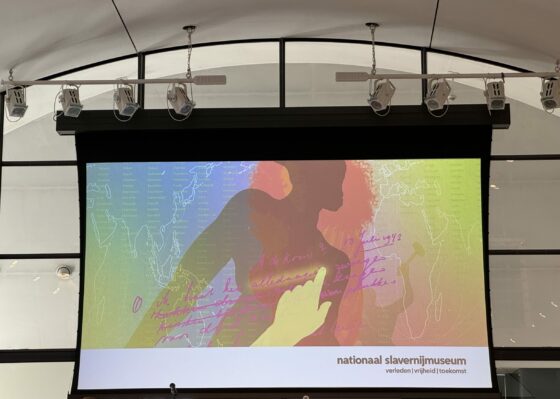Tell the whole story: slavery museum planned for Amsterdam
Senay Boztas
Amsterdam has announced long-awaited plans to build a new waterfront museum to “tell the whole story” of the Dutch history of slavery, which should open in 2030.
“This is a national history, a national slavery museum and with this national character in mind, the government has made money available to make the museum possible,” said junior culture minister Fleur Gräper-van Koolwijk on Thursday.
“A place where there is room for recognition, commemoration, healing, admission…not just for the relatives of enslaved people but for everyone. So also for people who think – ‘ach, a slavery museum isn’t about me.’ The Dutch slavery museum is about everyone.”
Although he was not present at the launch in Amsterdam, caretaker prime minister Mark Rutte, said the museum would be “an important part of the story after the comma, after the apology for the role of the Dutch state in the history of slavery.”
A formal apology for the Dutch role in slavery by Rutte in December 2022 said this was “not a full stop, but a comma” and set aside a €200 million fund to raise awareness of the Dutch trade in human beings and its consequences in modern society. It included €27 million for the slavery museum.
The launch event, attended by Surinamese ambassador Rajendre Khargi and US ambassador Shefali Razdan Duggal as well as the mayor of Amsterdam Femke Halsema, was also live streamed to Dutch countries in the Caribbean and to Suriname. There were also performances including Eurovision songster Jeangu Macrooy and the ZO! Gospel Choir, enthusiastically cheered by an audience of more than 400 people.
Amsterdam culture chief Touria Meliani said it was an “extraordinary moment”, after king Willem-Alexander’s apology for slavery on the 150th effective anniversary of the end of Dutch slavery last year. “An awareness of history is about more than knowing facts, more than droning numbers of years or names and places,” she said.
“An awareness of history means understanding how our world is as it is, and understanding how in our country so many people can live peacefully. But also understanding that so many of our country’s people have a deep-rooted pain, passed from one generation to another.
“An awareness of history means not looking away from the consequences of the past, the poverty and deprivation that so often affect people of colour while so much of the wealth is ‘white’…The museum will be a vital part…of building for the future.”

Water
David Brandwagt, from Amsterdam municipality, which is also supporting the project, said that Java island in Amsterdam had been chosen because people felt it was important for the museum to be near to water, have room for a park and be prominent and central but still accessible. He said the city wants to open a design competition for architects worldwide further in the planning process.
Peggy Brandon, one of the “quartermasters” who consulted 5,000 people about their visions for the museum, said it would tell multiple perspectives under a multilingual banner: “tell the whole story, about us and with us”.
It will include a knowledge centre, children’s museum and “a kitchen, where we can cook together and learn about each other’s cooking”. It will have six time slots which visitors can wander at will, choosing their own route through different narratives about this history.
By 1814, more than 600,000 enslaved African women, men and children had been shipped by Dutch slave traders to the American content and their labours exploited to fund a period of unprecedented wealth. Up to a million people were traded in Asia under the authority of the Dutch East India Company.
Truthful
The building plans and consultation for the slavery museum are now public and quartermaster John Leerdam advised a building of 9,000 square metres to tell stories to further “connection”. More experts will give advice before a definitive decision from the local and national government.
Carla Kabamba, an Amsterdam councillor, told Dutch News that that it was a “beautiful moment” and was positive that – despite elections in November and a potential right-wing national government – the museum still would go ahead.
“Budgets for this kind of thing are made years in advance, and even a right wing government is served by being truthful about a past that made this country rich and laid the basis for the industrial revolution,” she said
Brandon said that an international spirit of generosity and welcome will prevail alongside multilayered perspectives on a shared history. “Understanding is important and the museum hopes to contribute to a more understanding society,” she said at the launch event.
“It is important to let people work through their feelings, to offer a glass of water if people become emotional and – dare say it, very unDutch – that this glass of water will be free of charge.”
Thank you for donating to DutchNews.nl.
We could not provide the Dutch News service, and keep it free of charge, without the generous support of our readers. Your donations allow us to report on issues you tell us matter, and provide you with a summary of the most important Dutch news each day.
Make a donation